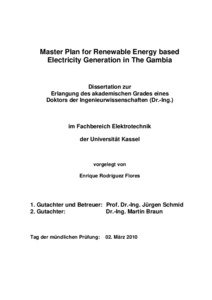| dc.date.accessioned | 2010-03-17T08:23:58Z | |
| dc.date.available | 2010-03-17T08:23:58Z | |
| dc.date.issued | 2010-03-17T08:23:58Z | |
| dc.identifier.uri | urn:nbn:de:hebis:34-2010031732340 | |
| dc.identifier.uri | http://hdl.handle.net/123456789/2010031732340 | |
| dc.description.sponsorship | Lahmeyer International GmbH | ger |
| dc.language.iso | eng | |
| dc.rights | Urheberrechtlich geschützt | |
| dc.rights.uri | https://rightsstatements.org/page/InC/1.0/ | |
| dc.subject | Renewable Energies | eng |
| dc.subject | Master Plan | eng |
| dc.subject | Africa | eng |
| dc.subject | Urban and rural electrification | eng |
| dc.subject.ddc | 620 | |
| dc.title | Master Plan for Renewable Energy based Electricity Generation in The Gambia | eng |
| dc.type | Dissertation | |
| dcterms.abstract | The principal objective of this paper is to develop a methodology for the formulation of a master plan for renewable energy based electricity generation in The Gambia, Africa. Such a master plan aims to develop and promote renewable sources of energy as an alternative to conventional forms of energy for generating electricity in the country.
A tailor-made methodology for the preparation of a 20-year renewable energy master plan focussed on electricity generation is proposed in order to be followed and verified throughout the present dissertation, as it is applied for The Gambia. The main input data for the proposed master plan are (i) energy demand analysis and forecast over 20 years and (ii) resource assessment for different renewable energy alternatives including their related power supply options. The energy demand forecast is based on a mix between Top-Down and Bottom-Up methodologies. The results are important data for future requirements of (primary) energy sources. The electricity forecast is separated in projections at sent-out level and at end-user level. On the supply side, Solar, Wind and Biomass, as sources of energy, are investigated in terms of technical potential and economic benefits for The Gambia. Other criteria i.e. environmental and social are not considered in the evaluation. Diverse supply options are proposed and technically designed based on the assessed renewable energy potential. This process includes the evaluation of the different available conversion technologies and finalizes with the dimensioning of power supply solutions, taking into consideration technologies which are applicable and appropriate under the special conditions of The Gambia.
The balance of these two input data (demand and supply) gives a quantitative indication of the substitution potential of renewable energy generation alternatives in primarily fossil-fuel-based electricity generation systems, as well as fuel savings due to the deployment of renewable resources. Afterwards, the identified renewable energy supply options are ranked according to the outcomes of an economic analysis. Based on this ranking, and other considerations, a 20-year investment plan, broken down into five-year investment periods, is prepared and consists of individual renewable energy projects for electricity generation. These projects included basically on-grid renewable energy applications.
Finally, a priority project from the master plan portfolio is selected for further deeper analysis. Since solar PV is the most relevant proposed technology, a PV power plant integrated to the fossil-fuel powered main electrical system in The Gambia is considered as priority project. This project is analysed by economic competitiveness under the current conditions in addition to sensitivity analysis with regard to oil and new-technology market conditions in the future. | eng |
| dcterms.accessRights | open access | |
| dcterms.creator | Rodríguez Flores, Enrique | |
| dc.contributor.corporatename | Kassel, Universität, FB 17, Elektrotechnik/Informatik | |
| dc.contributor.referee | Schmid, Jürgen (Prof. Dr.-Ing.) | |
| dc.contributor.referee | Braun, Martin (Dr.-Ing.) | |
| dc.subject.swd | Gambia | ger |
| dc.subject.swd | Elektrizitätserzeugung | ger |
| dc.subject.swd | Erneuerbare Energien | ger |
| dc.date.examination | 2010-03-02 | |

